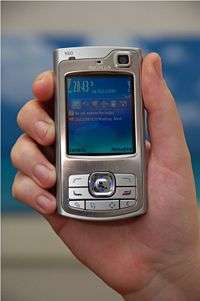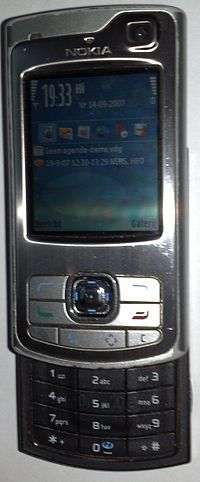Nokia N80
The Nokia N80 is a 3G smartphone from Nokia announced on November 2, 2005,[1] part of the multimedia Nseries line. It runs on Symbian OS v9.1 and the S60 3rd Edition interface. It was first released in June 2006.
 | |
| Manufacturer | Nokia |
|---|---|
| Series | Nokia Nseries |
| Compatible networks | GPRS, EDGE, WCDMA |
| Availability by region | Q2 2006 |
| Successor | Nokia N95 |
| Related | Nokia N70 Nokia N71 |
| Form factor | Slider, no spring assist |
| Operating system | Symbian OS (9.1), S60 3rd Edition (firmware v5.0719.0.2) |
| Memory | 40 MB storage memory |
| Removable storage | miniSD |
| Battery | BL-5B Battery, 3.7 V, 820 mAh |
| Data inputs | Keypad |
| Display | 352 × 416 pixels |
| Rear camera | 3.1 Megapixels |
| Front camera | 0.3 Megapixels (video calling) |
| Connectivity | WLAN b/g (100 mW instead of 250 mW standard) |
It has support for high-speed UMTS/WCDMA connections. Features include a 3.1-megapixel camera (interpolated from 2.0-megapixels) with built-in flash, a front camera for videoconferencing, Wi-Fi (802.11g), Universal Plug and Play (UPnP), FM radio, Bluetooth 1.2, MiniSD memory card slot, and support for 3D Java games. Its 2.1-inch display has a pixel density of 259 ppi due to the 352x416 resolution on a 2.1" displaymaking it one of Nokia's sharpest displays of 2005 and 2006.
The N80 was the world's first UPnP-compatible phone, allowing the transfer of media files to compatible devices over Wi-Fi.[2] The N80 was officially described as a multimedia computer by Nokia, like its successor Nokia N95.
Versions

- WCDMA/UMTS 2100 MHz for Europe/Asia.
- "Internet Edition" which is available in both US and European Versions.
Specification sheet
| Feature | Specification |
|---|---|
| Form factor | Slide |
| Operating System | Symbian OS (9.1) + Series 60 3rd Edition |
| GSM frequencies | 850/900/1800/1900 MHz |
| CPU | ARM-926 @ 220 MHz |
| GPRS | Yes, class 10 |
| EDGE (EGPRS) | Yes, class 11 |
| UMTS/WCDMA (3G) | 2100 MHz |
| WLAN | Yes (and UPnP), 802.11b/g supported |
| Main screen | TFT Matrix, 262,144 colors, 352 × 416 pixels |
| Camera | Front 0.3 Megapixels, 2× digital zoom & Rear 3.85 Megapixels CMOS w/LED flash, 20× digital zoom (5× in video rec.) |
| Video recording | Yes, MPEG-4 Simple Profile at CIF and H.263 at QCIF (max. clip length 2 hours) |
| Multimedia Messaging | Yes |
| Video calls | Yes |
| Push to Talk over Cellular (PoC) | Yes |
| Java support | Yes, MIDP 2.0, CLDC 1.1 |
| Built-in memory | 40 MB |
| NAND Memory | 128 MB |
| SDRAM Memory | 43 MB |
| Memory card slot | Yes, MiniSD(or MicroSD+Adapter), 2 GB Max. |
| Bluetooth | Yes, 1.2; Profiles supported: Basic Printing, Generic Access, Serial Port, Dial-up Networking, Headset, Handsfree, Generic Object Exchange, Object Push, File Transfer, Basic Imaging, SIM Access, and Human Interface Device |
| Infrared | Yes (The Infrared feature was missing from the Nokia N70 and due to demand it was put back onto the N80) |
| Data cable support | Yes |
| Browser | WAP 2.0 XHTML/HTML |
| Yes | |
| Music player | Yes, stereo |
| Radio | Yes, stereo, visual |
| Video Player | Yes |
| Polyphonic tones | Yes, 48 chords |
| MP3 ringtones | Yes |
| HF speakerphone | Yes |
| Offline mode | Yes |
| Battery | BL-5B (3.7 V, 890 mAh) |
| Talk time | 3 hours |
| Standby time | 192 hours |
| Weight | 134 g (4.7 oz) |
| Dimensions | 95.4×50×26 mm |
| SAR-Rating | 0.68 W/kg, 0.48 W/kg |
| Availability | Q1(2)/2006 |
| Else | QuickOffice office suite / Nokia Mini Map Browser |
Internet Edition
The Nokia N80 Internet Edition was a second version of this handset with the same hardware as the normal N80. It has been released in Q4 of 2006 and is available in Patina Bronze or Pearl Black, and has the following additional software included. As of January 2007, the Pearl Black model was available for sale in the US for $499.[6]
- Flickr
- 'Download!' App management
- Internet Telephone – SIP VOIP Frontend
- WLAN Wizard
Nokia have now announced that the new Internet Edition firmware is available for the 'classic' N80 by using Nokia Official Software Updater, downloadable from Nokia.com.
Before the Internet Edition firmware was made available on the Nokia Software Updater, end users could update the N80 to the same specification as an N80 Internet Edition by flashing the N80 with the firmware from the N80 Internet Edition.[7] This required the use of several hacked Nokia servicing software applications, including the Phoenix Service Software (or Nokia Software Update with Nemesis (by changing product code)). This method is of questionable legality in some jurisdictions, and may violate the terms of the phone's warranty. There are reports of the occasional failure of this method due to user error or for other unknown reasons, leaving the phone in an unusable state from which only a properly-equipped service center could recover it.
See also
References
- "Archived copy". Archived from the original on 2014-07-14. Retrieved 2014-07-07.CS1 maint: archived copy as title (link)
- http://www.mobiledia.com/news/39020.html%5B%5D Nokia N80 Enters the Digital Home as First UPnP Phone
- AAS Feature: Nokia N80 Preview
- "Bluetooth.org – The Official Bluetooth Membership Site". Archived from the original on 2005-12-28. Retrieved 2006-06-24.
- Nokia N80 (Unlocked) Smartphone reviews - CNET Reviews
- "LetsTalk.com – Landing Page". Archived from the original on 2009-02-10. Retrieved 2007-01-03.
- N80 – N80i firmware upgrade guide – All About Symbian Forums
External links
| Wikimedia Commons has media related to Nokia N80. |